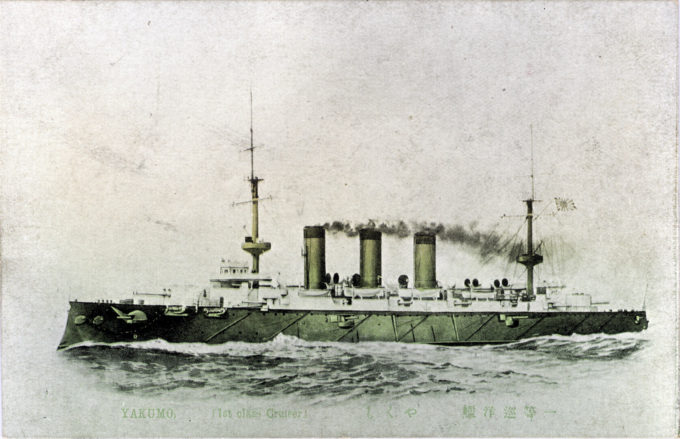
A commemorative postcard of the Imperial Japanese Navy training cruise to Hawaii, U.S.A., Mexico, Panama, 1924-1925. Commander of the Training Fleet [Renshū Kantai], Vice-Admiral Saburō Hyakutake, is shown in the photo inset. The three training ships, Asama, Izumo and Yakumo, the fleet’s navigational course across the Pacific Ocean, itineraries, and ports of call are also illustrated.
See also:
26th Voyage of the T.S. “Shintoku Maru”, c. 1935.
Imperial Japanese Navy Armored Cruiser “Azuma”, c. 1910.
“The Training Fleet of the Imperial Japanese Navy, the Renshū Kantai, operated from 1903-1940, with only a brief hiatus during the Russo-Japanese War (1904-1905). Graduates of the Imperial Japanese Naval Academy (Kaigun Heigakkō) would spend several months in training deployment largely throughout the Pacific Ocean and beyond, with their near-annual cruises occasionally venturing as far as the Mediterranean Sea or the East Coast of the United States.
“The coast defense ships Asama, Izumo and Yakumo [see below] departed Yokosuka Naval Arsenal on 10 November 1924 for the US West Coast with cadets of the 52nd class of the naval academy with an itinerary that included port calls at Hilo, Acapulco, Balboa, San Francisco, Vancouver, Honolulu, Jaluit Atoll, Truk, Saipan and the Ogasawara Islands. While in Vancouver, British Columbia, on 7 February 1925, a tugboat collided with one of the Izumo‘s launch boats at night, drowning 11 crewmen.
“Takakazu Kinashi served his midshipman duty during the 1924-1925 training cruise. He was promoted to ensign during the voyage, and on his return to Japan, he completed naval artillery and torpedo warfare training.
“Takakazu’s early career was not promising, as he graduated in very last place as 255th of 255 cadets in the 51st class of the Imperial Japanese Navy Academy in 1920. He later became a submarine commander in the Imperial Japanese Navy during World War II, and is noted for the sinking of the American aircraft carrier USS Wasp and destroyer USS O’Brien and severely damaging the battleship USS North Carolina– all with a single spread of six torpedoes as captain of the I-19 in 1942, southeast of San Cristobal in the Solomon Islands.”
– Wikipedia

Imperial Japanese Navy armoured cruiser Yakumo, c. 1910. Yakumo (八雲, Eight Clouds) was built in Germany 1897-99 because Japan still lacked the industrial base to do so. A major participant of battles during the Russo-Japanese War, lightly damaged during the Battle of Tsushima Straits, Yakumo saw no combat during World War I and began the first of many training cruises in 1917. After World War II ended, Yakumo became a repatriation ship. She was broken up and scrapped in 1946.

